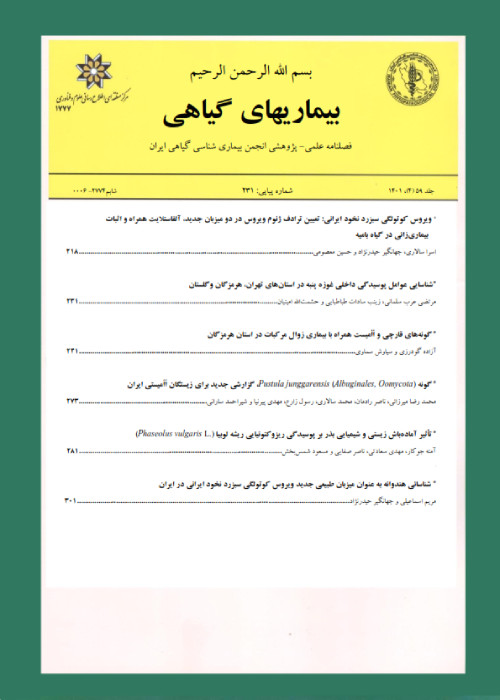FIRST REPORT OF NATURALLY OCCURRING Thanatephorus cucumeris (ANAMORPH: Rhizoctonia solani AG-1 IA) ON PADDY-RICE FIELDS FROM IRAN
Abstract:
Rhizoctonia solani Kühn AG 1-IA [teleomorph = Thanatephorus cucumeris (Frank) Donk] is the causal agent of rice sheath blight, which is one of the most serious diseases of rice worldwide in both tropical and temperate climates. The disease occurs throughout rice production areas in southern coast of Caspian Sea, the major rice growing region in Iran, and is considered as the most important rice disease on susceptible semi-dwarf, high-yielding cultivars. The perfect stage of the pathogen has been frequently observed on rice as well as on alternative hosts in several countries but up to now there has been no report from Iran. On August 2008, during a warm and humid season, rice plants (cv. Neda) from a hill with severe sheath blight symptoms bearing a superficial powdery growth spreading over tillers was observed at the beginning of ripening stage in a field near Amol, Mazandaran. Hymenia were effuse (Fig. 1A), cream to grayish white in color and composed of an arachnoid network of hyphae (7-11.5 µm in diameter) from which clusters of basidia were arisen. Light microscopic analysis revealed barrel-shaped basidia, subclavate, some cylindrical, slightly wider than the supporting hyphae, 11-16 × 7-9 µm (Fig. 1B). Sterigmata were long, stout, tapered, usually four (rarely two or three). Basidiospores were hyaline, oblong to ellipsoid, some obovate, with a prominent apiculus, 7.5-9 × 4-6 μm (Fig. 1C). On the basis of above characteristics, the Basidiomycetous fungus on rice was identified as T. cucumeris. This is the first report of naturally occurring T. cucumeris on rice plants in Iran. Single basidiospores germinating on water-agar were transferred to potato dextrose agar plates and incubated at 27°C. The fungal colonies was 2.1 and 4.0 cm in diameter after five and nine days of incubation, respectively. Colony was first snow white then became cream to beige. Hyphae resembled R. solani’s, especially in nearly right-angled side branches with basal constriction. For the pathogenicity test, rice seedlings (cv. Neda) were transferred to plastic pots containing rice field soil. Inoculation was done by placing a portion of the actively growing culture (derived from a single basidiospore) between leaf and stem of 40 day old rice plants. The glasshouse temperature varied from 27-32 °C and relative humidity from 90 5%. Plants were inspected for disease symptoms, one, two and three weeks after inoculation, but no lesion was observed. It is plausible that sexual basidiospores produced as a result of heterothallic mating might constitute an important aspect of the fungal life history contributing to the genetic diversity of field populations of R. solani AG-1 IA anywhere rice is cropped, including Iran.
Language:
Persian
Published:
Iranian Journal of Plant Pathology, Volume:47 Issue: 1, 2011
Page:
103
magiran.com/p867662
دانلود و مطالعه متن این مقاله با یکی از روشهای زیر امکان پذیر است:
اشتراک شخصی
با عضویت و پرداخت آنلاین حق اشتراک یکساله به مبلغ 1,390,000ريال میتوانید 70 عنوان مطلب دانلود کنید!
اشتراک سازمانی
به کتابخانه دانشگاه یا محل کار خود پیشنهاد کنید تا اشتراک سازمانی این پایگاه را برای دسترسی نامحدود همه کاربران به متن مطالب تهیه نمایند!
توجه!
- حق عضویت دریافتی صرف حمایت از نشریات عضو و نگهداری، تکمیل و توسعه مگیران میشود.
- پرداخت حق اشتراک و دانلود مقالات اجازه بازنشر آن در سایر رسانههای چاپی و دیجیتال را به کاربر نمیدهد.
In order to view content subscription is required
Personal subscription
Subscribe magiran.com for 70 € euros via PayPal and download 70 articles during a year.
Organization subscription
Please contact us to subscribe your university or library for unlimited access!



